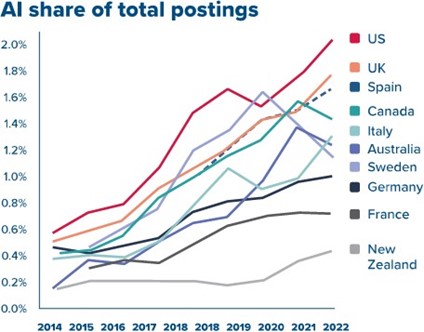In today’s rapidly evolving business landscape, technology has emerged as a powerful differentiator and catalyst for success. Businesses that effectively harness technology, combined with clean source data, enjoy limitless benefits, including real-time insights for strategic growth and risk mitigation, as well as employee empowerment and career advancement. However, striking the right balance between technology and talent demands a multi-faceted approach and presents challenges that need to be addressed.
Technology can empower employees, equipping them with new skills and driving career advancement. But the rapid pace of technological advancements can also generate concerns among employees and organizations. The World Economic Forum’s Future of Jobs Report 2020 predicted that in just two short years, by 2025, the time spent on current tasks at work by humans and machines will be equal. Employees often fear the dominance of technology, worrying about potential layoffs and the uncertainty of their roles in the face of automation. Organizations may also struggle to determine the right balance between technology and human resources, making it challenging to assess how much of each element is needed to achieve optimal performance.
Fear of New Technologies and Layoffs: The introduction of new technologies such as automation, artificial intelligence and machine learning has caused concerns among employees and companies about potential job displacements and layoffs. There have been discussions and studies about the impact of automation on the workforce and the potential for certain jobs to be replaced by technology. For example, repetitive and routine tasks are more susceptible to automation, leading to fears about job security for individuals in such roles.
Balancing the Human Element with Technology: Many organizations have found it challenging to strike the right balance between the human element and technology. While technology can enhance efficiency and productivity, it is essential to recognize that it is not a one-size-fits-all solution. Deciding how much to invest in technology and how it complements human capabilities can vary based on the industry, business model and specific goals of each organization. Striking this balance requires careful planning, skill assessment and strategic decision-making.
As organizations grapple with these issues, the demand for AI and related skills has experienced significant growth across global labor markets, with the U.S. and UK leading the charge. According to Lightcast data since 2014, the share of total job postings in AI fields has more than tripled in the U.S., UK and Canada.

Source: Lightcast™ 2023
To integrate this technology, companies need to focus on strategic leadership, transparent communication and a commitment to continuous improvement.
Setting the Tone at the Top: Cultivating a technology-driven culture starts with strong leadership. Executives must convey that technology is not merely a support function but a transformative force driving value throughout the organization. By promoting open lines of communication, management can enhance employees’ understanding of the organization’s system architecture, emphasizing technology’s pivotal role in supporting existing operations and future growth.
Crafting a Strategic Roadmap: Developing a comprehensive roadmap that aligns system architecture with strategic initiatives is crucial. Owned by the chief technology officer or equivalent, this roadmap should be adaptable to the ever-changing business landscape. Regular communication ensures alignment and keeps employees informed about the organization’s technology direction. Cross-functional alignment is facilitated by technology representatives who provide guidance as functional leaders establish goals supporting company growth initiatives.
Investing in Talent and Resources: Striking the technology-talent balance requires astute resource planning. Organizations should prioritize hiring individuals with both technical proficiency and business acumen. When talent gaps arise, leveraging talent outsourcing can bridge these deficiencies. Investing in training programs for all employees maximizes system utilization and adaptability. By nurturing a workforce equipped with technical and business-oriented skills, organizations optimize technology’s potential to drive success.
Embracing Continuous Improvement and Creativity: Commitment to continuous improvement and development of the organization’s system architecture is essential. Encouraging employees at all levels to interact with technology creatively fosters growth. This approach empowers users to acquire new techniques, troubleshoot issues and drive process efficiencies. Organizations can foster continuous improvement through feedback mechanisms, regular improvement cycles and firm-wide exercises. This feedback informs the roadmap, ensuring resource allocation based on priority and effective KPI development and monitoring.
Achieving a harmonious equilibrium between technology and talent demands a multi-faceted approach. Rather than fearing the dominance of technology, organizations must recognize the transformative power of striking the perfect balance between technology and talent. Effective leadership, transparent communication and a culture of continuous improvement are the keys to harnessing the full potential of both.
By embracing technology as an enabler and empowering employees to adapt and innovate, organizations can ensure that humans remain at the forefront of progress, driving success and thriving in a dynamic and ever-evolving business landscape. The future lies in the harmonious collaboration between human ingenuity and technological advancements, where the possibilities for growth and achievement are truly limitless.







